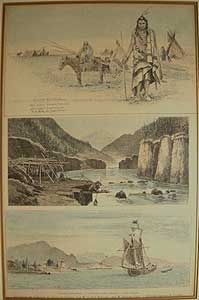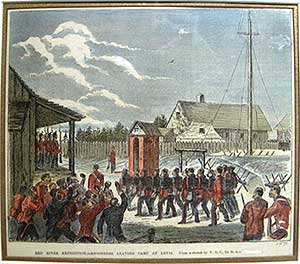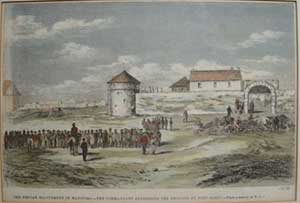The Creation of Manitoba 1869
The uncertainty of the Canadian government’s plans concerning Assiniboia, and the hardships caused by the 1868 plague of grasshoppers, caused the seeds of rebellion to flourish in spite of the fact that both Canadian and international relief was raised to diminish the distress. Using the pretext of survey for a proposed wagon road (see item 2) to assist in transporting relief aid, a further survey of the Red River Territory was instituted. The Métis were exacerbated by the rumored threat of annexation of Assiniboia by the United States via the Fenians. For the Métis, uncertain of their land tenure rights, this was too much. On October 11, 1869 Louis Riel brought the survey to a halt. With his foot on the surveyor’s chain, he and his 18 followers calmly informed the surveyors that “the Canadian Government has no right to make surveys in the Territory without the express permission of the people of the settlement”. The majority of the original white settlers agreed with him.
His timing was perfect, for the transfer of the H.B.C.’s Rupert’s Land to the Dominion had not being completed due to a certain lack of funds on behalf of the Government of Canada, so there was a general uncertainty as to who had jurisdiction. Moreover, there was still great difficulty in communicating with the settlement swiftly and this was complicated by the fact that neither London nor Ottawa claimed to have (nor indeed apparently cared to have) accurate knowledge of the local situation with regard to Métis land claims, in spite of the advice and warnings concerning the situation given to Ottawa.
Riel and his supporters formed ‘La Comité National des Métis de la Rivière Rouge’ which confronted William McDougall, the Governor-Designate, at Pembina, and forbade him entry to the settlement. Riel, realizing the strategic importance of Fort Garry, proceeded to occupy it on November 3. Whereupon, he set up a Provisional Government and issued his proclamation of 8th December,1869. Thus was Manitoba born.
Prime minister Sir John A. Macdonald reacted with uncustomary swiftness to contain the situation, by halting the transfer deal with the H.B.C., advising MacDougall to wait in Pembina for further instructions, and dispatching Bishop Taché to the Red River. He also dispatched as his emissary Donald A. Smith (later Lord Strathcona) with orders to placate and reassure the Métis that they would have representation within the new Dominion. Smith arrived at Fort Garry on the day of Riel’s proclamation.
Dateline: Manitoba 1870 -The Unrest Foments.
The first two months of the year at (upper) Fort Garry were taken up with the discussions of the Convention held to establish a provisional government for Manitoba, agreement being reached in the early hours of February 10/11. The volatile Reil was becoming increasingly erratic. It was during this period that some of Riel’s inhumanly treated prisoners escaped from the Fort, to try and raise an insurrection against Riel. One of them being W. J. Allen, a Sergeant in the Durham Light infantry from Port Hope. [Having made his escape, he was much fêted upon his return to Port Hope.] Another amongst them was the belligerent Orangeman, surveyor Thomas Scott. He was later recaptured and ordered by Riel, with whom he had a personal vendetta, to be shot on March 4 for his participation in the insurrection - an act which was to dog Riel for the rest of his life.
Feelings of revenge in the Orange order of Ontario against, and in Québec sympathies for, the new Province ran high, and were the cause for considerable concern to both MacDonald and Cartier, back in Ottawa. They strongly influenced the tone of the reception given the three Convention delegates to Ottawa. However, the outcome of negotiations resulted in the Manitoba Act of May 12, which limited the size of the new Province and acknowledged the rights of the Métis.
Meanwhile, a volunteer expeditionary force about 1,000 Canadian military under Colonel (later Field Marshal and Viscount) Garnet J. Wolseley (see item 6) arrived at Winnipeg on August 24th. after an arduous overland 1,500 mile trek via the Dawson Road, (see item 3) to find that Riel had departed for the United States. Eager for vengeance, the troops caused considerable bloodshed and such ill feeling (see item 5) among the Métis and settlers in the nine days prior to the arrival of the first Lieutenant Governor of the Province, Adams G. Archibald, an able and just man, that many Métis removed to the North West Territory (see item 10). There they nursed their discontent for another 15 years, whilst cherishing their traditional way of life. The Red River Rebellion was over, while the seeds of yet another lay dormant.

















